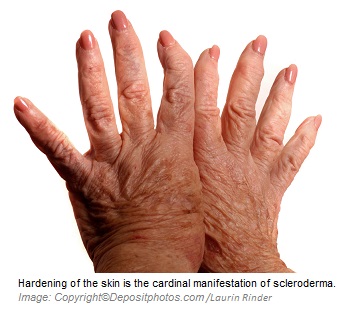It is a chronic connective tissue disease characterized by hardening of the skin,
 involvement of the internal organs, widespread small vessels diseases, and hyperactive immune system. Involved internal organs include heart, lungs, kidneys, and gastrointestinal system.
involvement of the internal organs, widespread small vessels diseases, and hyperactive immune system. Involved internal organs include heart, lungs, kidneys, and gastrointestinal system.
The disease could affect the hands and face only, which is called localized scleroderma
The disease is three to four times more common in women than in men. The disease most often affects people 30 to 50 years old. It is considered an autoimmune disease, leading to overproduction and deposition of collagen.
Potential contributing factors:
- Genetics.
- Coal miners, possibly due to exposure to silica dust.
- Viral infections.
- Toxins: exposure to PVC (polyvinyl chloride), trichloroethylene, and other organic solvents.
- Medications: bleomycin.
- L-Tryptophan and 5-HTP. They might cause a scleroderma-like skin problem called “eosinophilia-myalgia syndrome”.
- Adhesive and coating materials.
- Hormones.
- Nutritional deficiencies, especially vitamins D and E, copper and zinc.
Nutritional Supports:
Restricted Foods:
- Saturated fats.
- Trans-fats.
- Sweets and sugar.
- Processed foods.
- Foods containing gluten: wheat, breads, oats, rye, barley, semolina, spelt, kamut, couscous, and triticale.
- Too much fiber: it may decrease motility of the colon, causing abdominal cramps and pain.
- Alcohol.
- Foods high in inulin: inulin is a soluble fiber that causes overgrowth of methane-producing bacteria, which leads to bloating and gas. Low quantities of these foods seem unproblematic. However, avoid high quantities. The foods are bananas, burdock, chicory, garlic, leek, onions, wild yam, artichoke, and dandelion.
- Caffeine.
- Foods high in linoleic acid (a type of Omega-6): safflower, sunflower, sesame, and grape seed oils. Linoleic acid is a pro-inflammatory.
- Foods high in “Solanine”: potatoes, tomatoes, eggplant, and peppers. Solanine aggravates inflammation.
- Foods high in anthocyanins: berries, purple grapes, eggplants, beets and red cabbage. Anthocyanins are water-soluble flavonoids that may interact with collagen metabolism by inhibiting proteolytic enzymes involved in the degradation of collagen and cross-linking collagen fibers, making them more resistant to collagenase action.
- Foods high in L-tryptophan: turkey, shrimps, scallops, and fish.
Recommended Foods:
- Plenty of water: 2 -3 liters a day.
- Gluten free diet.
- Legumes.
- Flaxseeds.
- Fresh fruits and vegetables.
- Avocado.
- Soybeans.
- Foods high in GLA (gamma linoleic acid): evening primrose oil, borage oil, black currant oil, canola oil, walnuts, flaxseeds, chia, and hemp seeds. GLA is a type of Omeg-6 fatty acid with an anti-inflammatory property.
Recommended Supplements:
- Vitamin E: 800 – 1200 IU a day. You may apply vitamin E cream to the affected areas as well. Vitamin E is an antioxidant with anti-fibrotic activity.
- Vitamin D: 2000 – 5000 IU a day. This vitamin has an ability to inhibit the growth of fibroblasts and collagen synthesis.
- Omega – 3 Fatty Acids: 2 – 3 grams a day.
- PABA (para-aminobenzoic acid): 10 – 12 grams a day. PABA has an anti-fibrotic activity.
- NAC (N – Acetyl Cysteine): 500 – 1000 mg a day. NAC may improve involvement of the fingers.
- SAMe (S – Adenosylmethionine): 600 – 1200 mg a day. SAMe may reduce hardening of the skin.
- Bromelain: 1500 – 2000 mg a day. It has an anti-inflammatory effect.
- Digestive Enzymes: A broad spectrum product.
- Probiotics: take a product that provides 5 to 10 billion active organisms per serving.
- Aloe Vera Juice: ¼ to ½ cup three times a day.
- Gotu Kola Extract: 30 – 90 mg a day. Gotu kola contains saponins (asiaticoside, madecassoside, and madasiatic acid) that may inhibit the production of collagen.
- Multivitmains – Multiminerals: A high potency product.
Miscellaneous Suggestions:
- Liver detoxification.
- Acupuncture.
- Therapeutic exercise and stretches.

